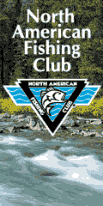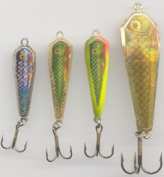





















Free 90 day Risk free trial offer click
here

|
LAST DANCE WALLEYES
By John Kolinski
Editorís Note: John Kolinski is an eight-time championship qualifier
during his seven years of professional fishing on the Professional Walleye
Trail and the
Masters Walleye Circuit.
Itís no secret that I love to spoon-feed walleyes.
During the open-water months, itís a technique generally reserved for clear-water
situations where walleyes cruise the edges of steep breaks and feed on
flashy baitfish.
Thereís no better feeling in fishing than giving
life to an otherwise innate blade of metal, dropping the rod tip, feeling
a hit, and setting the hook into a solid walleye.
Winter and hard water offer a whole new wonderland
for spooning up walleyes.
Over the years, Iíve run across only a handful of
anglers who regularly include spooning in their ice-fishing arsenals.
They know how effective it can be whether walleyes are aggressive or sluggish.
Overall, however, itís a technique that is just beginning to catch on,
a fact reflected by the recent push from the manufacturers to get new spoons
on the market.
Spooning works for many of the same reasons that
make jigging, trolling, casting and slip-corking effective - a walleyeís
basic need to eat. Our job as anglers is to make it easy and efficient
for the walleyes to do that.
We accomplish that goal by understanding the particular
stage a walleye is in during its seasonal cycle, evaluating water conditions
and the walleyeís mood, and offering it something that closely resembles
it immediate forage base. We can use color, vibration, action and
scent to provoke that action.
Spooning addresses each of these issues. Itís
a technique that works well early in the ice-fishing season when the walleyes
are more aggressive, and throughout the season for that matter.
But when it comes to late-winter walleyes, itís
often an approach that works when nothing else will.
The primary attraction of jigging spoons is visual.
The effective ones are flashy, and designed to vibrate when the angler
lifts the rod tip, then flutter back in a side-to-side motion on the fall.
They simulate the appearance of any number of baitfish walleyes might be
feeding on.
It follows that spoons will be most effective in
clear water. Thatís the case during the open-water season, and thatís
what makes them my top choice in late February and even early March, or
as long as safe ice lasts.
From lakes and reservoirs to river backwaters and
impoundments with current, a cover of ice and snow limits the elements
that can affect water clarity. Boat traffic and wind donít exist.
In effect, the water gets a chance to settle, and clear.
The types of areas I target with my spoons are the
more gradual, sloping edges of breaklines, whether thatís on Little Bay
de Noc, Mille Lacs Lake, Lake Oahe or any other body of water that harbors
a strong walleye population. Inside turns on old river beds can be
hotspots, as can long, tapering sand flats.
Good electronics are a must for a proper spooning
presentation. Jigging a spoon in water where you hope there are fish
isnít nearly as much fun or as interactive as jigging where you know there
are walleyes lurking.
Spooning success relates to the equipment an angler
uses, as well.
I use a fairly stiff, 3-foot jigging stick that
will move the spoon several feet with minimal effort. Iíve found  8-pound Micro Ice line is ideal for this approach. Itís a low-stretch,
small-diameter line that allows the lure to work and vibrate the way itís
intended while providing quick, solid hooksets.
8-pound Micro Ice line is ideal for this approach. Itís a low-stretch,
small-diameter line that allows the lure to work and vibrate the way itís
intended while providing quick, solid hooksets.
To help prevent line twist, which is bound to occur
when youíre jigging a spoon with so much side-to-side and vibrating action,
try using a barrel swivel about 16-18 inches above the lure.
Once Iíve pinpointed suspended walleyes on my electronics,
I always try to work my lure about a foot above them. If they move
toward the lure, I raise it another six inches, and it seems like the next
time I drop it is when they bite. Donít drop the spoon all the way
down to the fish. From my experience, that seems to spook them every
time. Iíve seen them come up off the bottom to inhale a spoon, but
they donít seem to show much interest when you try to hand-feed them.
In general, Iíve found that a subtle jigging approach
usually produces the strikes. Too many times, Iíve seen walleyes
move away when I become more aggressive after locating fish. The
same tantalizing action that enticed them to stop and take a look is usually
the action that will get them to bite. Anything more often sends
them scooting elsewhere.
As with most jigging applications, however, youíll
have to let the walleyes tell you what they want. Sometimes, itís
a slight twitching motion. Other times, itís a subtle lift-and-drop
that works. And on occasion, an aggressive popping technique will
trigger bites.
One thing to remember is that your lure is actually
traveling two to three times further than the rod tip when you impart action.
You donít want to take that spoon away from an interested walleye by moving
it four or five feet.
On those days when you can see walleyes cruising
the bottom, but you canít get them to come after a spoon, try pounding
the lure right into the bottom. It will stir up the bottom a bit,
like something a walleye might want to eat, while also creating a little
extra noise that may attract fish.
Occasionally, walleyes wonít settle for anything
that doesnít taste like a minnow or grub. One of the assets of a
good jibbing spoon is that it can be tipped with a piece of minnow, a spike
or a grub without affecting the action, which gives the angler another
method of presentation for finicky fish.
In most situations, Iím fishing in water deeper
than 10 feet. That makes 1/8-ounce and 1/4-ounce spoons the right
choice. On darker days, fluorescent colors work well. On brighter
days, natural golds and silvers are my choice.
Not all spoons are created equal. In fact,
there arenít many that offer all the characteristics I believe are essential
to consistently catching walleyes. Fortunately,  allowed me to design the Lindy
Rattl'r spoon
allowed me to design the Lindy
Rattl'r spoon
 I wanted the spoon to look somewhat like a baitfish, but with a larger
head than a tail. One of the keys with spoons is creating a design
that pushes the limit in regard to action, but not to the point where you
canít retrieve the spoon without the line tangling in the hooks.
I wanted the spoon to look somewhat like a baitfish, but with a larger
head than a tail. One of the keys with spoons is creating a design
that pushes the limit in regard to action, but not to the point where you
canít retrieve the spoon without the line tangling in the hooks.
We experimented with a number of prototypes before settling on a design
that imitates a crippled baitfish and offers a consistent and manageable
action. Another unique feature of the Rattl'r
is the way it slides back when you drop your rod tip. I think it
triggers more reactionary bites than any other spoons Iíve tried.
As the name implies, this new spoon has a built-in-rattle. That
doesnít mean it creates the commotion of a shot-filled crankbait.
These rattles are contained in a small tube, and they simply click once
when you lift the lure and once when you drop it. Subtle is usually
the secret to successful ice fishing. I got another chance to put the Rattl'r
to the test during a recent outing. It produced seven legal walleyes
and a few bonus crappies from the same holes where minnows and grubs got
only a brief look. The difference these spoons made couldnít have
been more dramatic. The Lindy Rattl'r
comes in several 3-D, holographic color patterns. You can check them
out on Lindyís web site at  .
No matter what type of spoons you choose, I hope youíll try a little last-dance
spooning as the winter wears on. Itís a deadly two-step that keeps
the angler involved, and often puts walleyes on the ice when others are
going home empty-handed. .
No matter what type of spoons you choose, I hope youíll try a little last-dance
spooning as the winter wears on. Itís a deadly two-step that keeps
the angler involved, and often puts walleyes on the ice when others are
going home empty-handed.

Walleyes Inc. web site is maintained
by Randy
Tyler Fishing the In-Fisherman Professional Walleye Circuit, Masters
Walleye Circuit, RCL and the Team Walleye Circuit. All rights reserved.
Copyright 1999/2001
Please visit these site sponsors
Daiichi/Tru-Turn Hooks,
Lindy
Little Joe,
R-A.M Mounting Systems,
Ranger
boats, Mercury Marine, Bedford
Sales , Hamby's Beaching Bumpers,
Goldeneye
Marine products, Panther
Marine Products, Webfoots body
sock, Bait Rigs Tackle
|



